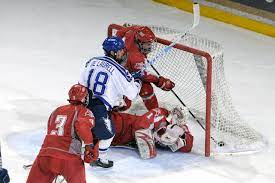How Long Are College Hockey Games?
If you’re a hockey fan, you may be wondering, “How long are college hockey games?” The average NHL game lasts 2 hours and 20 minutes, with three 20-minute periods and a 17-minute intermission. Each game also has three commercial zones, lasting anywhere from 45 seconds to two minutes. Several factors can affect the length of a game, including weather conditions and penalties.
20 minutes
High school hockey games usually feature three periods of 15 minutes, but college hockey games feature longer periods of up to 20 minutes each. There is also a 15-minute intermission in between periods. If a game ends in a tie, college hockey games have a 10-minute sudden-death overtime period. If the teams are still tied after that period, they play a five-minute shootout. In addition, the NHL and college hockey use 20-minute overtime periods during play-offs.
Most professional hockey leagues have a regulation game time of three periods of 20 minutes each, with an additional 15-minute period in the Stanley Cup playoffs. These games are about two hours long in most cases, but many amateur and junior leagues vary game times. This can allow teams to adjust the length of their games to accommodate other games on TV.
Before the advent of the National Hockey League, most college hockey games were played with two 30-minute periods. The shortened periods made it difficult for players to rest between periods. In addition, the ice became uneven and hard to play on, causing pucks to bounce funny and players to have trouble maneuvering. The NHL eventually changed the rules to include three periods of 20 minutes.
College hockey games are the same length as NHL games. These games are often more entertaining and less competitive. However, they still feature many penalties. In general, each period of play is 20 minutes long, with a 15-minute intermission in between. If no team scores in overtime, the game will be called a tie.
In the NHL, the overtime period is 20 minutes long. During the regular season, games last approximately 2 hours. However, the time for the NHL playoffs is longer than in regular hockey, with the second period lasting 15 minutes. In youth hockey, games typically last from 12 to 20 minutes.
Overtime is 5 minutes
There are some concerns with the current overtime format for college hockey games. While the Big Ten has five minutes of 5-on-5 OT and a shootout that awards an extra point in the conference standings, the NCHC and WCHA have five minutes of sudden death 3-on-3 OT. While these formats aren’t perfect, they aren’t bad either.
Overtime for college hockey games will be five minutes long, and penalties are called just like they do in a regular 60-minute game. The team that is penalized will be reduced to three skaters while the team that is awarded the power play will be reduced to four skaters. The teams will then play four-on-four until the whistle blows, at which point they will switch roles and play 3 on 3.
Overtime in NHL playoff games is five minutes long. The goal is to end the game with a winner. The period lasts until either team scores a goal or the game goes into a shootout. The NHL’s overtime rules are a little different. A five-minute period is only allowed when a team scores a goal during the previous two periods. However, shootouts do last five minutes.
The NCAA has also changed the overtime format in college hockey. The new format is more like that of the NHL and American Hockey League. Games that end in a tie after regulation time will go to a five-minute period of three-on-three hockey. If the game is still tied after the overtime period, it will go into a three-person shootout. However, this format will only be used in conference play for league points and for advancement.
Penalties affect the time frame
Penalties affect the time frame of college games in a variety of ways. In the Big Ten, for example, officials have begun to crack down on obstruction, hitting from behind, and contact to the head. Coaches are also making adjustments to their defensive strategies and teaching players how to adjust to the new rules.
When a penalty is incurred, an additional player can be sent to the penalty box. The additional player is not permitted to play until the first penalty has expired. This is referred to as a stacked penalty. When a team has two consecutive penalties, they are forced to play with two skaters on the ice.
Penalties in college hockey games affect the time frame in a variety of ways. A minor penalty, for example, involves two minutes in the penalty box. A minor penalty, which is the most common, will expire if the opposing team scores on its power play. A major penalty, on the other hand, requires a player to serve a full five minutes.
College hockey has been adopting a standardized three-on-three overtime period this season. This overtime period will be contested at the end of 60 minutes of tie-scoring hockey. While the argument against the system is that the vagaries of 3-on-three overtime shouldn’t have a significant impact on national rankings, the reality is that the new system is both suboptimal and confusing.
Weather conditions affect the time frame
The time frame of college hockey games is often affected by the weather. For instance, if it is particularly cold, teams may be forced to play indoors. To prepare for such conditions, teams should hydrate and bring along appropriate clothing. If the weather forecast calls for snow or rain, teams should take necessary precautions to prevent any damage to the equipment or the ice.
